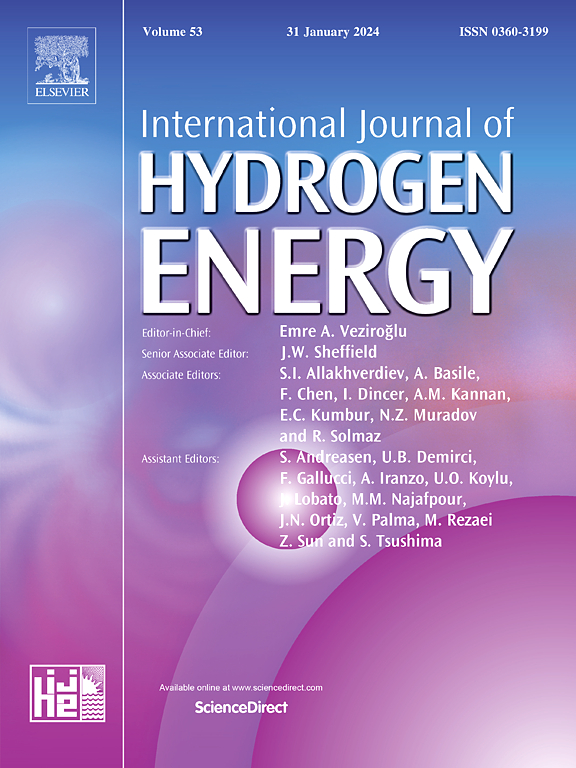一种高效的rh基La2Ce2O7柴油蒸汽重整催化剂:催化剂结构对其性能的影响
IF 8.3
2区 工程技术
Q1 CHEMISTRY, PHYSICAL
引用次数: 0
摘要
开发具有良好的抗焦化性能和耐硫性能的柴油重整催化剂是一个巨大的挑战。一般来说,强金属-载体相互作用(SMSI)在决定催化性能中起着关键作用。本研究比较了负载型(Rh/La2Ce2O7)和嵌入型(la2ce1.89 rh0.1107)催化剂,发现活性金属的晶格嵌入策略显著提高了SMSI,提高了催化活性。活性测试表明,嵌入型催化剂la2ce1.89 rh0.1107表现出更好的低温活性,在650°C时实现了几乎完全的柴油转化率(~ 100%),而负载型催化剂在750°C时仅达到~ 85%的转化率。650 ~ 850℃稳定性试验进一步证实了la2ce1.89 rh0.1107的高稳定性,850℃时H2产率为70.4%。对催化剂的表征证实,嵌入型(Rh3+由部分取代的Ce4+实现)引发了强烈的SMSI效应,在载体内诱导电子重构,即将Ce4+促进为Ce3+,从而产生高浓度的氧空位。此外,还形成了高度分散的Rh纳米团簇(平均尺寸为2.5 nm,分散度为44.0%)。所有这些结构特征共同形成了一种具有优异的抗焦化和耐硫性能的催化剂。综上所述,本研究为通过点阵嵌入定向调控SMSI提供了一个很好的例子,为开发高性能车载柴油制氢催化剂提供了有益的指导。本文章由计算机程序翻译,如有差异,请以英文原文为准。

A highly-efficient Rh-based La2Ce2O7 catalyst for steam reforming of diesel: Effect of catalyst structure on performance
The development of high-performance catalysts with good coking resistance and sulfur tolerance for diesel reforming has been a big challenge. Generally, the strong metal-support interaction (SMSI) plays a pivotal role in determining the catalytic performance. This study investigated comparatively a supported-type (Rh/La2Ce2O7) and an embedded-type (La2Ce1.89Rh0.11O7) catalyst, and revealed that lattice-embedding strategy for active metals significantly enhances SMSI and improves catalytic activity. The activity tests demonstrated that the embedded-type catalyst La2Ce1.89Rh0.11O7 exhibited a better low-temperature activity, achieving a nearly-complete diesel conversion (∼100 %) at 650 °C, whereas the supported-type catalyst only reached ∼85 % conversion at 750 °C. Stability tests in 650–850 °C further confirmed the high stability of La2Ce1.89Rh0.11O7, with a H2 production rate of 70.4 % at 850 °C. Characterization of the catalysts confirmed that the embedded type, in which Rh3+ was implemented with partially substituted Ce4+, triggered a strong SMSI effect, inducing electronic reconstruction within the support, i.e. promoting Ce4+ to Ce3+, thus creating a high concentration of oxygen vacancies. Additionally, the highly dispersed Rh nanoclusters (with average size 2.5 nm, dispersity 44.0 %) were formed. All these structural features had collectively resulted in a catalyst of exceptional anti-coking and sulfur-tolerance properties. In summary, this study provided a good example for the oriented regulation of SMSI through lattice-embedding, which offered a useful guidance for the development of high-performance catalysts for on-board hydrogen production from diesel.
求助全文
通过发布文献求助,成功后即可免费获取论文全文。
去求助
来源期刊

International Journal of Hydrogen Energy
工程技术-环境科学
CiteScore
13.50
自引率
25.00%
发文量
3502
审稿时长
60 days
期刊介绍:
The objective of the International Journal of Hydrogen Energy is to facilitate the exchange of new ideas, technological advancements, and research findings in the field of Hydrogen Energy among scientists and engineers worldwide. This journal showcases original research, both analytical and experimental, covering various aspects of Hydrogen Energy. These include production, storage, transmission, utilization, enabling technologies, environmental impact, economic considerations, and global perspectives on hydrogen and its carriers such as NH3, CH4, alcohols, etc.
The utilization aspect encompasses various methods such as thermochemical (combustion), photochemical, electrochemical (fuel cells), and nuclear conversion of hydrogen, hydrogen isotopes, and hydrogen carriers into thermal, mechanical, and electrical energies. The applications of these energies can be found in transportation (including aerospace), industrial, commercial, and residential sectors.
 求助内容:
求助内容: 应助结果提醒方式:
应助结果提醒方式:


